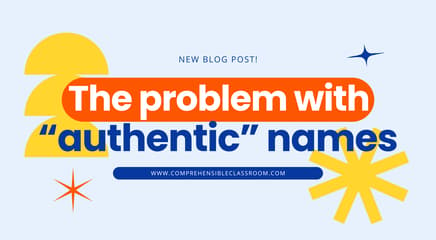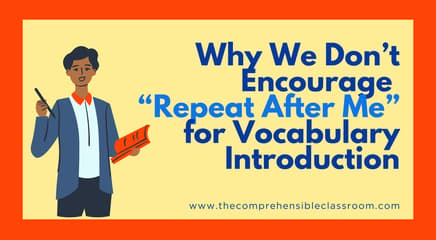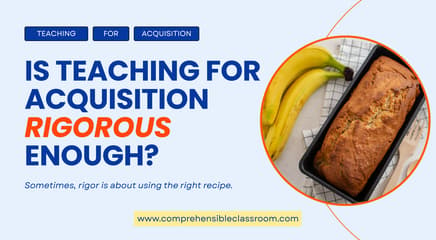When language acquisition is the goal, planning for language classes requires things to talk about and things to read. Bracket-style competitions are a perfect interactive, input-rich activity that creates the perfect conditions for language acquisition to happen, and in this post I'll tell you why.
What IS a bracket competition?
If you're familiar with sports playoffs, you're familiar with bracket competitions. A bracket competition is a tournament that is made up of several rounds. You begin the tournament with a list of "contestants" that will compete for some kind of title. The number of contestants can vary, but it should be a multiple of 4 (4, 8, 16, 32, etc.).
The contestants in each round face off in paired matches, and the winner of each match goes on to the next round to compete against the winner of a different pair.

How to create a Bracket Competition
All you need for a Bracket Competition is a list of contestants and a title for which they are competing. Here are some ideas:
- Animals / Most Adorable Animal
- Initialisms (LOL, BRB, etc.) / Most Frequently Used
- Sports / Most Likely to Break your Fingernail
- Fast Food Restaurants / Best French Fries
- Furniture / Most Necessary
- Music Artist / Most Likely to Be Teacher's Alter Ego
- Food / Strongest Smell
You can create the list yourself, find a pre-made bracket on a site like Bracket Fights, or have your students develop the list!
Three tips for building brackets:
- Brackets are a GREAT way to "cover" required vocabulary from a textbook unit in a meaningful way. Most important room in the house, Best ride at an amusement park, Favorite adjective, Most dangerous school supply... the possibilities are endless!
- Using Proper Nouns will lead to the easiest to understand discussions. If you're teaching beginning language students, brackets built out of Proper Nouns (restaurants, brand-name candy, sports teams, etc.) will make comprehension easy.
- Pulling together images that represent each of the contestants will greatly support students in understanding the discussion, but it's not necessary. All you need is a list of words, but a list of words plus pictures to represent the words is even better.
Arrange your list of contestants into pairs for matches. You can be strategic about this, so that the pairs facing off in each round are closely matched (in your estimation), or you can do it randomly.

How to conduct a Bracket Competition
Once you've got your list of contestants and the title, you can bring it to your class!
1. The first step is to Establish Meaning.
Show students the full list of contestants and let them know what your Core Question is. Your Core Question is the title for which the contestants are competing. For example:
- Which animal is most adorable?
- Which Initialism do you use the most?
- Which Fast Food Restaurant sells the best French Fries?
Your first job is to make sure that your students understand this Core Question. If they do not understand the Core Question, they will be lost and disengaged through the entire activity. Use whatever techniques you have to help students understand, and remember that linking meaning to their first language is the most efficient and effective way to be certain that all students understand the question accurately. Don't be afraid to tell them what the Target Language (TL) question means in their L1.
After you're certain that students understand the Core Question, introduce them to the contestants! Name all 16 things that will be competing for the title. Try to help students understand what each contestant is (the meaning of the TL words), but you can take this job more seriously when you get to the first-round matches. At this point, you're giving them a general overview of what's to come.
2. Begin the first match!
Phew, it's already time to begin! Tell and/or show students what the first match is. This is a great time to use processing or circling questions to help students understand the conversation. Plus, it will give them repeated exposure to the language forms you are using, which will aid in acquisition.
First, repeat your Core Question. Then, name the two contestants in the match:
Ex: Which animal is most adorable: kittens or hedgehogs?
Now is the time to make sure your students understand what the two contestants are! If the match is kittens vs. hedgehogs and you are saying gatita and erizo in your Spanish class, make sure that your students know that gatita means kitten and erizo means hedgehog!
Remember that the most effective and efficient way to ensure that students are accurately interpreting something you're saying is to tell them what it means. Linking meaning to their L1 or to your primary shared language is a fast way for them to confidently understand what you're saying and to be able to fully participate in the discussion moving forward. If they doubt their interpretation at all, their focus will be distracted as you continue the conversation. Get everyone on the same page so that you can all move forward together!
Once you're certain that all students understand the match-up and the Core Question, it's time to communicate!
Make defining statements
Begin by making statements. Define each of the contestants, in your Target Language. For example, "This is a kitten; This is a hedgehog."
Ask the first question
After making one of the definition statements, ask a yes/no version of the Core Question: "Are kittens adorable?" Get an initial response from your students. You can leave this as a simple yes/no or raise-your-hands vote, or you can talk about different students' responses with a mixture of statements and more questions. Some examples of things you can say include:
- Damon says that kittens are adorable.
- Damon, you say that kittens are adorable?
- Damon (whose hand is raised), are kittens adorable?
- Celeste, look at Damon. Does he think that kittens are adorable?
After asking a question, turn it into a declarative statement, confirming the correct answer to whatever you were asking.
If you're working with a super beginner class and/or you don't want to spend much time on the bracket competition, you could do a formal vote right now and determine a winner for the match-up. Or, you can keep going!
Make descriptive statements
After students have given their initial response, start describing each thing. The goal here is to come up with answers to the question, "WHY [is a kitten adorable]? Since "Why" questions can be quite difficult to answer--especially because students need to focus on responses that they know how to say in the target language--you may find it helpful to ask descriptive questions. This is particularly true with beginners!
A question like, "What does a kitten have?" will lead students to say things like, "A kitten has big eyes," "A kitten has an adorable tongue," etc. Allow students to answer the question with short phrases in the class L1. You can quickly translate them into the target language for students and embed them in statements and questions.
Whenever new statements are made, ask processing questions! Processing questions help students to understand discourse by clarifying meaning and by giving more time to each idea. Processing questions are one of the most important techniques for a language teacher to develop!

Match discourse to proficiency
Allow the conversation about each match-up to be as simple or complex, linguistically, as is appropriate for your students' level of proficiency. Beginners can do a simple yes/no vote. Students that have some acquired language can understand and possible make short descriptive statements. Intermediate and Advanced level speakers may be able to compare/contrast and debate! Bracket competitions are super flexible, which makes lesson planning for multiple preps easy!
At the end of your match-up, identify the Victor, and advance it to the next round of competition.
More match-ups
Continue running first-round match-ups until all of your contestants have paired up, and you have a Victor for each pairing. Then, move on to the next round! The winners from the first round will now face off against each other, again in pairs. You'll keep going until you have ONE final Victor!
What makes Bracket Competitions Work?
Bracket style competitions work for building linguistic proficiency. Learners acquire language when they engage with communicatively embedded input that they can process, and bracket-style discussions or competitions are a perfect springboard for communication that creates the right conditions for students to acquire language. Here’s why:
It's authentic communication.
Bracket Competitions provide a little bit of entertainment, a little bit of connection , and a little bit of learning. This means that it's hitting all three purposes for communication that Dr. Bill VanPatten identifies in the ACTFL publication, While We're On The Topic.
This matters because we acquire language when we are exposed to communicatively-embedded comprehensible input. We acquire language when we're using it for a purpose to accomplish a task, and we understand it. In this case, the task involves a lot of interpretation and some expression!
Bracket Competitions is input-focused.
Primarily, this is a listening activity. Sure, students will have the chance to express meaning, but any one student will spend the majority of the class period listening to the teacher and their classmates. Students are hearing the teacher ask many questions in the Target Language (TL) and restate students’ answers, in addition to responses from their classmates.
Best of all? Bracket Competitions don't FEEL like listening activities. They are very interactive, which means they are a perfect example of what we like to call Secret Input!
Bracket Competitions make it easy to make input comprehensible.
While discussions about each match have the opportunity to become very complex, they don't have to be. At its heart, a Bracket Competition requires a very low vocabulary range. It naturally supports sheltering of vocabulary!
This matters because we can only acquire language that we understand. If you hold a class discussion that some students in your language class understand deeply, but some students in your class are only understanding occasional words or phrases, the students in the first group will have the chance
It’s easy to limit the vocabulary range of the discussion to what your students can interpret because you can trim it down to just your Core Question plus the list of contestants. If you choose to discuss reasons, defend choices, and debate; the vocabulary range can soar... but it doesn't have to!
Bracket Competitions support level-appropriate output.
If students are only ready to express meaning with visual cues (like raised hands) or one word answers, they can still engage in the activity. They can vote for their choice in each pair with a yes/no or by naming the item. Meanwhile, intermediate and advanced learners can describe, explain, compare/contrast, and more as they discuss each pairing. No matter what kind of output a learner is ready to produce, they can use it to engage actively in this activity.
Bracket Competitions are personalized.
The activity is personalized. Activities that are more intrinsically motivating are those that are relevant to students’ lives and interests. This activity is all about students’ preferences and opinions, which makes it truly Student-Centered.
Bracket Competitions
Learners acquire language when they engage with communicatively embedded input that they can process, and bracket-style discussions or competitions are a perfect springboard for communication that creates the right conditions for students to acquire language.
Tournament of Awesomeness
While many language teachers are likely familiar with March Music Madness, the OG Bracket Competition for language classes--as far as I am aware--is the Tournament of Awesomeness. This was an idea that Nathan Black blogged about on Michele Whaley's blog way back when I was beginning my journey toward Acquisition Driven Instruction. Michele and Nathan both implemented it and blogged about it quite a bit! Read the archives »
In their original version of the tournament, students were divided into teams. Each team would propose one thing to compete for the title of “most awesome.” The tournament lasted many days, and it was a highlight of the year for their students. This is the perfect example of how you can level-up the discourse in a Bracket Competition to match students' level of proficiency!
We created materials that you can use to implement a super simplified version of the Tournament of Awesomeness. The contestants for the title of Most Awesome Thing are already decided, and the amount of time spent on the tournament could be a single class period or many class periods. It’s up to you, and how in-depth you’d like to discuss each item and pairing before voting.
Grab our bracket in Spanish, French, English, or German:
Spanish teachers, remember that this El torneo de la genialidad product is included in the Tesoro Subscription! Learn more here »








